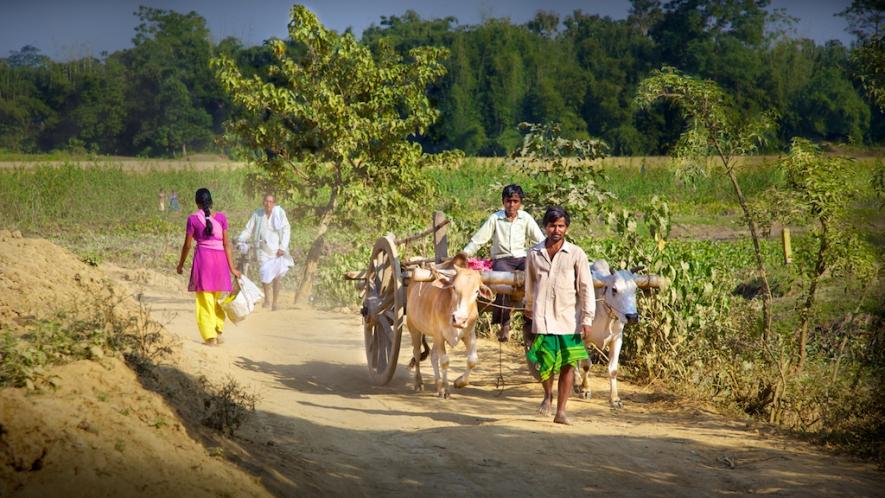How to Emerge From Stagnation? Strategies to Empower Rural India

Image Courtesy: flickr
Continuing the discussion on transforming the Indian economy and society, this is the second part of a two-part article by Nilakantha Rath. In this instalment, the author delves into different parametres of comprehensive development that need attention, including electrification, land reform and communication infrastructure. Read the first part of the article here.
-
Universal Electrification:
Providing electricity to every household, rural and urban, has been accepted as state policy for a long time in India. But it has not happened. We no longer have a single state government department responsible for generating, transporting, and distributing electricity to every village and urban area. Different companies, public and private, carry out these three tasks.
Following the de-departmentalisation of electricity, the World Bank proposed the creation of different regional companies for the distribution of power. In a few states, such private companies were auctioned this task. But many states have single government companies for power distribution. The experience under both these organisational systems has not been satisfactory. In one state, where four private companies were given the responsibility of power distribution, the experience has been far from satisfactory. Let aside the expansion of electrification in the rural areas, even the maintenance of supply in already connected villages is not done satisfactorily. Where there is a single state-level company for distribution, all troubles seen during departmental functioning are noticed. It is high time we think of a different pattern.
If a government company (or even a private one) is to be removed from this task, the employees will be unhappy. It would be better if the distribution work, in a Block or sub-division, is taken over by private producer companies whose shareholders would be the workers in the distribution company now being disbanded.
These companies should be separate producer companies under section 25 of the Companies Act, which are practically producer co-operatives. All workers in the company shall be the owners of the shares of this company, none else. When a shareholder ceases to be a worker, his share is to be returned to him, and any new worker should become a shareholder. This workers' company, from the engineer to the lowest level worker, will be responsible for the management of the company. In such a company there will be much less chance of power theft. Further, better earnings will result in a greater effort to expand the power supply. One reason why power supply in villages is often not universal is that the companies charge a separate connection charge for installing a meter to start the power supply. Many villagers find this to be expensive. Many years ago, we had estimated that if the company installed power connections in every house in the village without any installation charge, people would gladly become buyers. This universal power supply in the village will help the company quickly recover the installation cost. Greater use of power will reduce the per-unit distribution cost and will be to the producer company's advantage.
-
Renting of Public Land Space:
Even when a village has access to electricity and an all-weather road, a major obstacle to establishing small-scale non-farm enterprises is the lack of suitable accommodation. Land is prohibitively expensive for these entrepreneurs, and at best, only a small vacant house may be available for rent. Village data across the upland region of India reveal that in this vast area, each village has a minimum of four hectares (with an average of six hectares) of what is known as an uncultivable wasteland. The majority, if not all, of this land, can be developed, levelled, and prepared to accommodate small-scale processing units.
Currently, these lands are under state ownership. The most effective approach to make them suitable for such enterprises is to transfer the land ownership to the Village Panchayat. The Panchayat can develop the land, construct necessary roads, and provide electricity and water infrastructure. A portion of this land can be allocated for the village bus stand, while the remainder can be utilised for various types of processing units. Instead of selling the land, it should be rented to interested parties for a period not exceeding 25 or 30 years. The rent should be increased annually, but no more than the consumer price index for the area.
Those leasing the land can erect movable walls within the rented area and establish the processing unit. The Village Panchayat can impose a condition that only village residents can be employed in these units. If, after a couple of years, the organiser of the processing unit finds it untenable to continue, they can simply terminate their rental agreement. This arrangement offers excellent convenience and can foster the emergence of numerous small-scale enterprises at the village level.
When I shared this proposal with some interested friends for discussion, an NGO organiser from the Kalahandi district of Odisha (which gained prominence due to Rajiv Gandhi) wrote to me expressing encouragement and hoping that the state government would take it up. He recounted an instance where a women's self-help group in a village decided to establish a paddy de-husking unit. They managed to find a small vacant house for rent and successfully started their operations. The mill's success prompted them to explore other ventures such as dal making, oil pressing, and various spice production, including turmeric, coriander, cumin, and chilli powder. However, they encountered difficulties related to accommodation.
In the current system, the government provides a set of clothing to every child attending primary to high school. A tailor can establish their business in the village, employing locally trained machine operators to produce uniforms for the students, as well as pants, shirts, blouses, and other garments for the village population. Similarly, individuals needing nuts and bolts can set up small-scale lathe machines for manufacturing purposes. Women's self-help groups involved in goat and sheep rearing can consider establishing small-scale slaughterhouses to supply meat to villages and towns. The processed skins can also be transformed into various types of footwear directly within the village. The possibilities are abundant, if not limitless.
The crucial step in this endeavour is to make the land available for rent. The most effective approach is to transfer ownership of the uncultivable wasteland to the Gram Panchayat.
-
Communication:
There was a time when telephones were badly sought in villages and towns. Fortunately, it is no more so. Most villages and all towns today are in a position to have mobile phones. The recent pandemic has shown the usefulness of this service for not only medical services but more so for education and news. But the service is currently not uniformly satisfying. The adequacy of service depends upon towers to facilitate wireless connection. And this is left almost entirely to private enterprise. In rural areas, the state-owned BSNL has the largest number of towers. But, in recent times, the BSNL is substituting, in towns, the towers as well as its copper wire telephone lines with fibre optic broadband connections.
For towns and long-distance connections, the few private companies who provide the bulk of this service have begun to lay such fibre optic lines. As the trend shows, in the ultimate analysis, this service will become a monopoly, with all its consequences. Technologists tell us that fibre optic lines are the best because they are the fastest for transmitting data and information over long and short distances.
Small and medium service units wanting to provide different types of service to various users in both businesses and households will find it worthwhile if faced with a non-monopolist broadband service provider. This is possible only if the state provides this service over the country's surface. In the late 1990s, when the mobile service was fast opening up, the Indian Railways announced that they would lay such fibre optic lines all along the railway tracks without any land cost. After starting enthusiastically, they have stopped doing this for some reason. And private companies – one or two with deep pockets – have begun doing so.
This is a field where monopoly is the most harmful because its uses are far-reaching and open to small, medium, and large service providers in various fields. It is needless to stress that this infrastructure is best provided by the state, which will operate in the wide public interest. For cross-country conveyance, the lines by the side of the rail track are the best. Every state government can/should have state companies lay such lines along state and district highways and into the villages along village approach roads. The municipalities and corporations should lay such lines in the towns and cities to be rented by various service providers. This is the best way of providing the service at a competitive price. It is necessary for the governments at the centre and the states to undertake such infrastructure creation at the earliest.
4. Land Reform:
Land reform, that is, regulation of tenancy and land holding, was one of the first things done soon after independence. There was a ceiling on cultivated land holding by individuals and households and distribution of the surplus to the landless for cultivation and/or for building houses by persons without any land. Tenancy in cultivated land was sought to be regulated. To begin with, the ceiling on the rent of agricultural land was fixed, and tenants could not be dispossessed at will. In some states, where this law was found inadequate, ownership of tenanted land was transferred to the tenant. New tenants, created after this law, were permitted to purchase the land from the landowner at a legally fixed price after eleven months. Tenancy could continue only on lands used for growing sugarcane and banana. This was done more than 50 years ago in practically all states. A lot of water has flown below the bridge since then.
Today, tenancy in agricultural land continues in states that did not pass a land-to-the-tiller law. But, the extent of tenancy is much less. Rents are lower. The most important development in this matter has been the decline in the area under cultivation, particularly in the upland region of peninsular India. It has happened because medium and small cultivators with uplands under cultivation find it unrewarding to cultivate such lands with rather low yields under rain-fed conditions. They also find it too expensive to cultivate such lands with hired labour. Two things help such households to keep such land fallow: one, the younger male workers of the family migrate to urban areas for work and send money home; two, free rice, five kilos per head, reduces the need for putting such land under crop.
Further, the landless do not want to rent such lands for cultivation. This phenomenon is the least in the floodplain lands of the river deltas of the east coast and the Gangetic plains. It is time for a change in the approach to tenancy law.
It is necessary to give up the legal provision of purchase of the leased land by the tenant within a year. Instead, the law should lay down that renting shall be for a period of five years at a time, renewable on mutual consent. The unirrigated land can be rented at around a hundred rupees per acre per year. It is very likely that such land will be rented by women's self-help groups who may use the land to grow grass or a variety of pulses, essentially for green fodder for the goats and sheep they herd. The result would be a growing enterprise nationwide, particularly in the upland peninsular region.
Such tenancy law will facilitate not only the use of such lands but also help goat and sheep breeding in the countryside by women of the lower income households. In certain situations, such lands may be put to non-agricultural use on a rental basis. We have proposed renting publicly owned unculturable wasteland in the villages by the Gram Panchayat. Some owners of unirrigated uplands in such villages may decide to rent their land for these purposes through the Gram Panchayat. For them, of course, the rent will be decided by the Panchayat, along with other terms and conditions. The basic advantage is that the lands will be used, but the land ownership will not be changed.
Concerning other farmlands, the present legal position of permitting the tenants to purchase the tenanted land within a year of renting should be done away with. The tenancy period should be five years at a stretch for all types of farmland.
For farmland, the rental should be fixed by law. Since many small land-owning households are likely to see earning members of the family going out for non-farm work, this possibility of renting out the land without losing ownership will facilitate out-migration. Indeed, the sale of land to public or private companies so far has seen many takers wasting their capital resources and getting trapped in poverty. In this case, the better way is to lease out the land for non-farm use, with a provision for an automatic increase in the annual rental (at the rate shown by the rise in the consumer price index).
Nilakantha Rath, Emeritus. Fellow, Indian School of Political Economy, Pune. The views are personal.
Get the latest reports & analysis with people's perspective on Protests, movements & deep analytical videos, discussions of the current affairs in your Telegram app. Subscribe to NewsClick's Telegram channel & get Real-Time updates on stories, as they get published on our website.
























